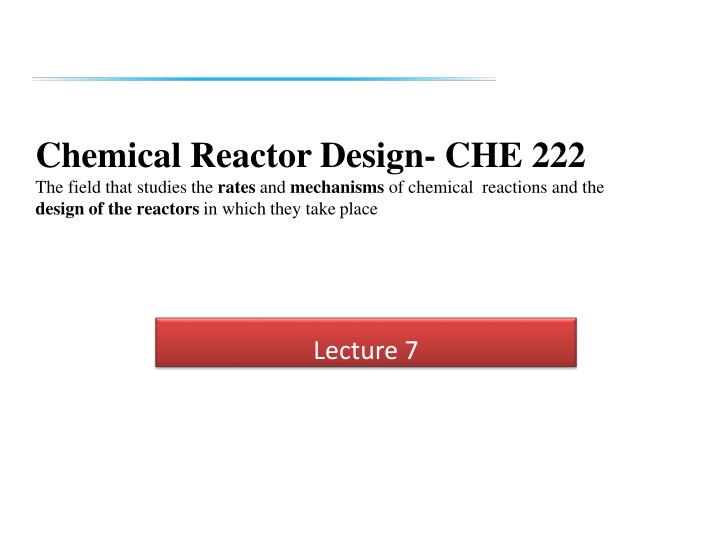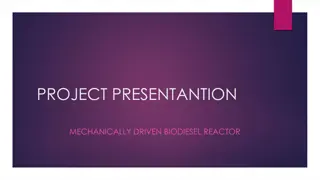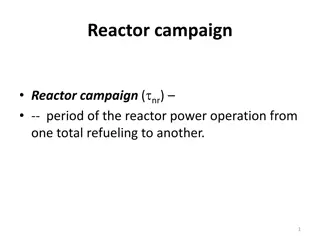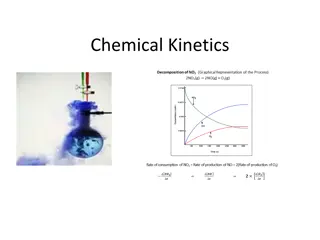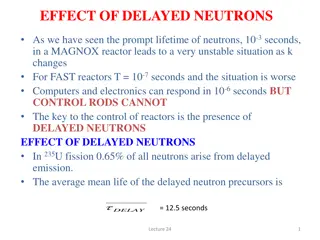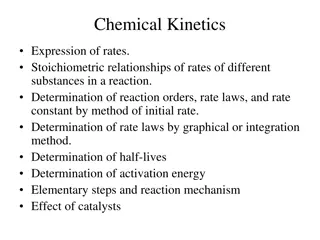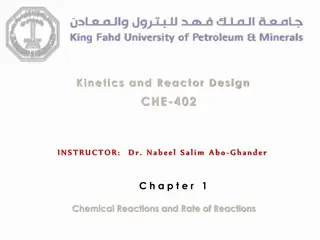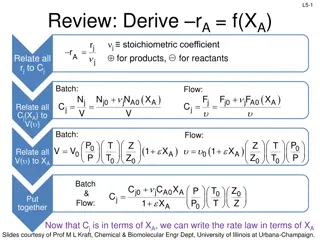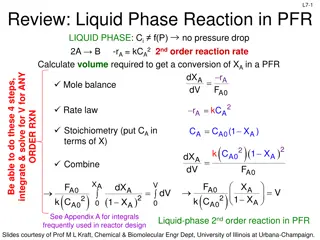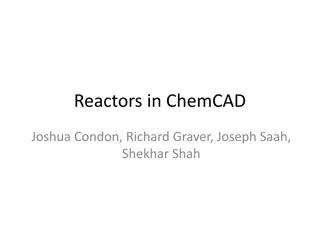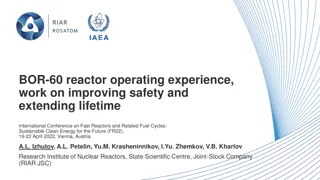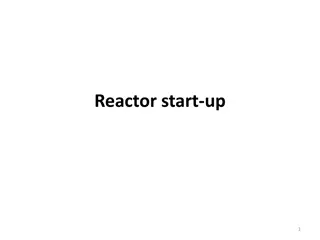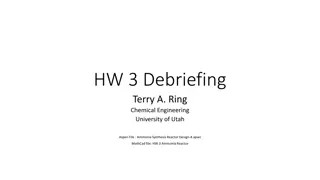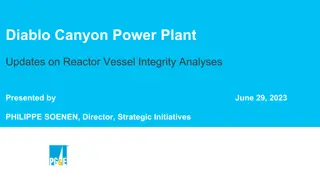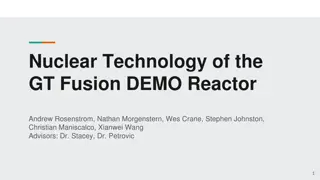Chemical Reactor Design: Rates, Mechanisms, and Reactor Types
The field of chemical reactor design encompasses studying reaction rates, mechanisms, and designing reactors for various processes. Factors such as reaction type, production scale, cost, safety, and more influence the choice of reactor scheme. Understanding reactor systems and applying engineering judgment are essential for optimal design in chemical processes.
Download Presentation

Please find below an Image/Link to download the presentation.
The content on the website is provided AS IS for your information and personal use only. It may not be sold, licensed, or shared on other websites without obtaining consent from the author.If you encounter any issues during the download, it is possible that the publisher has removed the file from their server.
You are allowed to download the files provided on this website for personal or commercial use, subject to the condition that they are used lawfully. All files are the property of their respective owners.
The content on the website is provided AS IS for your information and personal use only. It may not be sold, licensed, or shared on other websites without obtaining consent from the author.
E N D
Presentation Transcript
Chemical Reactor Design- CHE 222 The field that studies the rates and mechanisms of chemical reactions and the design of the reactors in which they take place Lecture 7
Chapter Six: Design for Single Reactions There are many ways of processing a fluid: in a single batch or flow reactor, in a chain of reactors possibly with interstage feed injection or heating, in a reactor with recycle of the product stream using various feed ratios and conditions, and so on. Which scheme should we use? Unfortunately, numerous factors may have to be considered in answering this question; for example, the reaction type, planned scale of production, cost of equipment and operations, safety, stability and flexibility of operation, equipment life expectancy, length of time that the product is expected to be manufactured, ease of convertibility of the equipment to modified operating conditions or to new and different processes. With the wide choice of systems available and with the many factors to be considered, no neat formula can be expected to give the optimum setup. Experience, engineering judgment, and a sound knowledge of the characteristics of the various reactor systems are all needed in selecting a reasonably good design and, needless to say, the choice in the last analysis will be dictated by the economics of the overall process. The reactor system selected will influence the economics of the process by dictating the size of the units needed and by fixing the ratio of products formed. The first factor, reactor size, may well vary a hundredfold among competing designs while the second factor, product distribution, is usually of prime consideration where it can be varied and controlled. 2
In this chapter we deal with single reactions. These are reactions whose progress can be described and followed adequately by using one and only one rate expression coupled with the necessary stoichiometric and equilibrium expressions. For such reactions product distribution is fixed; hence, the important factor in comparing designs is the reactor size. We consider in turn the size comparison of various single and multiple ideal reactor systems. Then we introduce the recycle reactor and develop its performance equations. Finally, we treat a rather unique type of reaction, the autocatalytic reaction, and show how to apply our findings to it. Design for multiple reactions, for which the primary consideration is product distribution, is treated in the next two chapters.
6.1 SIZE COMPARISON OF SINGLE REACTORS Batch Reactor First of all, before we compare flow reactors, let us mention the batch reactor briefly. The batch reactor has the advantage of small instrumentation cost and flexibility of operation (may be shut down easily and quickly). It has the disadvantage of high labor and handling cost, often considerable shutdown time to empty, clean out, and refill, and poorer quality control of the product. Hence we may generalize to state that the batch reactor is well suited to produce small amounts of material and to produce many different products from one piece of equipment. On the other hand, for the chemical treatment of materials in large amounts the continuous process is nearly always found to be more economical. Regarding reactor sizes, a comparison of Eqs. 5.4 and 5.19 for a given duty and for = 0 shows that an element of fluid reacts for the same length of time in the batch and in the plug flow reactor. Thus, the same volume of these reactors is needed to do a given job. Of course, on a long-term production basis we must correct the size requirement estimate to account for the shutdown time between batches. Still, it is easy to relate the performance capabilities of the batch reactor with the plug flow reactor.
6.2 MULTIPLE-REACTOR SYSTEMS Plug Flow Reactors in Series and /or in Parallel Consider N plug flow reactors connected in series, and let XI, X,, . . . ,X, be the fractional conversion of component A leaving reactor 1,2, . . . ,N.Basing the material balance on the feed rate of A to the first reactor, we find Hence, N plug flow reactors in series with a total volume V gives the same conversion as a single plug flow reactor of volume V. For the optimum hook up of plugflow reactors connected in parallel or iany parallel-series combination, we can treat the whole system as a single plugflow reactor of volume equal to the total volume of the individual units if thefeed is distributed in such a manner that fluid streams that meet have the same composition. Thus, for reactors in parallel VIF or T must be the same for eac parallel line. Any other way of feeding is less efficient. The reactor setup shown in Fig. E6.1 consists of three plug flow reactors in two parallel branches. Branch D has a reactor of volume 50 liters followed by reactor of volume 30 liters. Branch E has a reactor of volume 40 liters. What fraction of the feed should go to branch D? 8
Branch D consists of two reactors in series; hence, it may be considered to be a single reactor of volume VD= 50 + 30 = 80 liters Now for reactors in parallel VIF must be identical if the conversion is to be the same in each branch. Therefore, Or Then, two-thirds of the feed must be fed to branch D. Equal-Size Mixed Flow Reactors in Series Let us now quantitatively evaluate the behavior of a series of N equal-size mixed flow reactors. Density changes will be assumed to be negligible; hence E = 0 and t= 7. As a rule, with mixed flow reactors it is more convenient to develop the necessary equations in terms of concentrations rather than fractional conversions; therefore, we use this approach. The nomenclature used is show in Fig. 6.4 with subscript i referring to the ith vessel. 9
Second-Order Reactions. We may evaluate the performance of a series of mixed flow reactors for a second-order, bimolecular-type reaction, no excess of either reactant, by a procedure similar to that of a first-order reaction. Thus, for the same processing rate of identical feed the ordinate measures the volume ratio VN/Vp, directly. N reactors in series we find Comparison of performance of a series of N equal-size mixed flow reactors with a plug flow reactor for the first-order reaction: 12
Comparison of performanc of a series of N equal-size mixed flow reactors with a plug flow reactor for elementary second- order reactions: 13
The sketch of Fig. E6.2 shows how the performance chart of Fig. 6.6 can be used to help solve this problem. (a) Find the conversion for the same treatment rate. For the single reactor at 90% conversion. kCo = 90 For the two reactors the space-time or holding time is doubled; hence, the operation will be represented by the dashed line kCo = 180 This line cuts the N = 2 line at a conversion X = 97.4 14
(b) Find the treatment ratefor the same conversion Staying on the 90%conversion line, we find for N = 2 that kCo = 27.5 , point b Comparing the value of the reaction rate group for N = 1and N = 2, we find Since VN=2 = 2VN=1 the ratio of flow rates becomes Thus, the treatment rate can be raised to 6.6 times the original. Note. If the second reactor had been operated in parallel with the original unit then the treatment rate could only be doubled. Thus, there is a definite advantage in operating these two units in series. This advantage becomes more pronounced at higher conversions. 15
